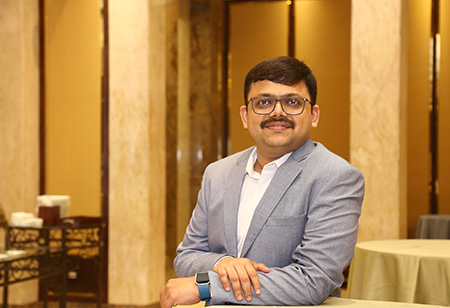
Sameera Damle, with nearly 20 years of experience, began as a software engineer in engine and infotainment systems, later excelling in application engineering, sales, business development, and product management across India, SEA, and ANZ. Having worked at Delphi and ETAS, he now drives growth at Ansys through industry collaboration and innovative solutions.
Automotive lighting has undergone an extraordinary transformation over the last decades. It began with modest halogen lamps and has now evolved into highly sophisticated systems that incorporate sleek-looking OLED strips, adaptive driving beams, matrix LEDs, and even laser lighting. These advancements have redefined how vehicles are perceived aesthetically and have significantly enhanced safety, driver comfort, and the overall customer experience.
If one looks at the pace of innovation in the automotive industry, the journey from simple visibility-focused systems to intelligent lighting solutions, mirrors the rapid pace of innovation in the automotive industry. The old lighting systems were designed with only visibility as the purpose. Nowadays, lighting serves numerous roles and also contribute to brand identity through signature designs.
The lighting market growth is currently being driven by many factors. There is an increase in demand for safety and comfort, and this takes automotive lighting from a functional feature to something that is a competitive differentiator. The rise of advanced driver assistance systems (ADAS), electric vehicles (EVs), vehicle-to-everything (V2X) communication, and software-defined vehicles also have given rise to a cross domain impact. Lighting systems have been therefore pushed to become smarter, more integrated, and more adaptive to real-time conditions.
Emerging technologies including matrix LEDs, adaptive driving beams, laser-based lighting, and dynamic sequential lighting systems are opening up new options. Automotive lighting therefore spans a wide range of applications – headlights, taillights, signal lights, head-up displays (HUDs), infotainment systems, interior ambient lighting, displays, instrument clusters, and even integrated sensor housings for cameras and LiDAR.
Also Read: Role of Smart Tyres in Powering EVs and Autonomous Mobility
Advancing lighting technologies also come with some challenges. Automakers often encounter compromises when it comes to newer styling requirements and also the optical and thermal performance required to ensure safety and efficiency. It is a continuous challenge for design and engineering teams all over the world to try and get the perfect balance between aesthetic appeal and functional excellence.
The integration with complex electronics and software systems is another challenge. Modern lighting often needs to interact in a smooth manner with on-board sensors, driver assistance features, and networked communication systems. Therefore, meticulous engineering and testing is essential for synchronization across domains.
One more key aspect today is sustainability. Manufacturers must ensure that designs, materials, and processes meet the strict standards while ensuring performance, especially with regulatory mandates for recycling and environmental compliance.
To ensure safety and performance, automotive lighting is also subject to stringent global regulations and standards like photometric standards for light intensity and beam patterns, thermal and environmental durability requirements, and recycling compliance mandates. Designs today must meet AIS, ECE, SAE, FMVSS, and UN regulations for beam patterns, glare control, and safety. Evolving V2X lighting functions also might need to comply with future communication and signalling protocols. Meeting these regulations is key to avoid redesigns that could prove costly and also to ensure market readiness.
Given these challenges, traditional methods of trial-and-error prototyping is neither efficient nor cost-effective. The industry is increasingly turning to simulation and virtualization as they help in accelerating development cycles, improving design accuracy, and ensuring compliance – all this early in the process. With simulation, engineers can evaluate how a lighting design will perform across optical, thermal, structural, and environmental parameters – way before the physical prototypes are built.
Advanced optical simulation allows lighting engineers to model beam patterns, glare control, and human vision perception in a range of driving conditions. With virtualization, they can integrate the lighting system into a complete 3D vehicle environment, and also test it in real-world scenarios – all without even having to leave the design studio.
In this regard, Ansys offers an end-to-end multiphysics and multiscale optical simulation platform that supports the entire automotive lighting development process. This includes:
They allow engineers to cater to creative and technical requirements without any negotiation.
Automotive lighting teams can considerably fast-track their time-to-market by adopting advanced simulation tools. Early virtual testing cuts the need for multiple physical prototypes. This reduces development costs and also resource consumption.
Simulation also helps manufacturers attain compliance readiness well ahead of physical certification tests, thus minimizing regulatory risks. And more importantly, it empowers designers to push the boundaries of styling while maintaining and even improving the optical and thermal performance.
In a market where lighting plays an increasingly important role in brand identity, safety, and user experience, these advantages are critical. Multiphysics accuracy, design flexibility, and workflow efficiency, when combined, positions simulation as a must-have capability for the future of automotive lighting development.
Lighting today is no longer just about seeing the road but it’s about integrating safety, aesthetics, and digital intelligence into an all-new unified experience. With vehicles becoming smarter, safer, and more connected, it’s clear that the future of mobility will be illuminated not just by beams of light, but by innovation itself.
We use cookies to ensure you get the best experience on our website. Read more...